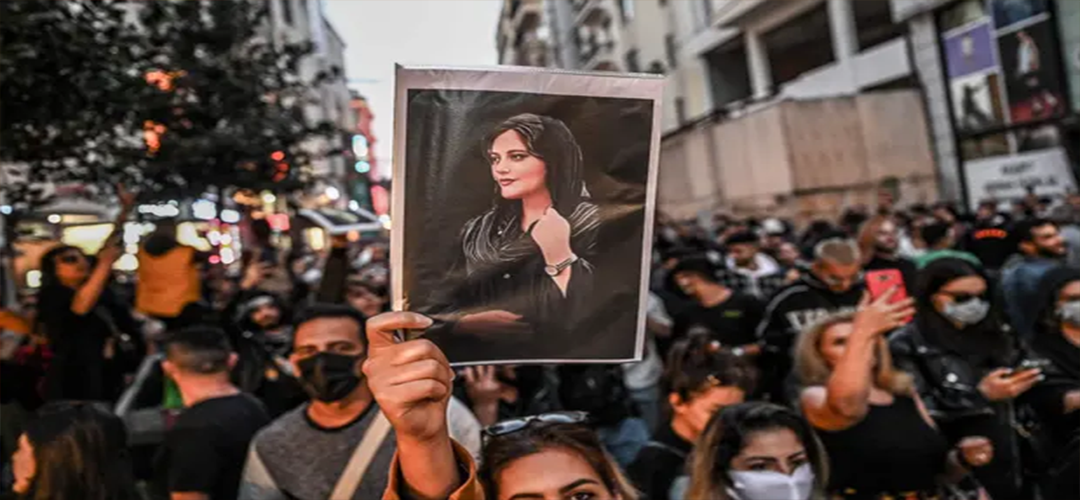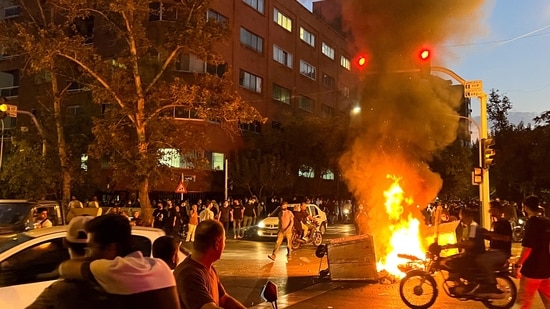“WOMEN, LIFE, FREEDOM”
September 24, 2022 | Expert Insights

Iran, a highly theocratic state, is witnessing astounding acts of defiance from women. Young women are at the forefront everywhere, from remote villages to the steps of Tehran University. Several footages show second-class citizens, a term appropriated to Iranian women, challenging and breaking the conservative notion of how a woman is supposed to behave in public.
All this very public protest spontaneously broke out following the death of Mahsa Amini, a 22-year-old student in police custody for allegedly failing to adhere to hijab laws. However, this was not a sudden outburst, as forty years of religious restrictions that disproportionately target women have fuelled deep resentments. Most protests have taken place in Iran's Kurdish-populated northwest, but they have also spilled to Tehran and at least 50 other cities and towns around the country. In defiance, young women have taken off and, in some cases, burned their headscarves. Since the unrest began over the weekend, at least 31 people have died, and many were injured as a result of the state's repression
The disturbance reflects a larger discontent with Iran's conservative leadership over the state of the country's crippled economy, pervasive corruption, and social restrictions.
Background
Following the Islamic revolution, the nation was subject to stringent sharia law, which imposed severe limitations on women, making it necessary for them to cover their hair and wear long, baggy clothing to hide their bodies. All individuals who transgressed these standards were publicly chastised, fined, and even arrested. The constitutional referendum of 1979 (Iranian revolution) marked a crucial turning point when Iranians chose to live under Islamic laws.
The "hijab and chastity" directive that Mr Raisi issued in an effort to exert greater control has given the morality squads more power. A human rights organisation claims that their men, dressed in black and armed with batons, had sent hundreds of women to morality homes for "re-education."
In 2014, Iranian women started posting pictures and videos online openly disobeying the hijab restrictions as part of a "My Stealthy Freedom" online protest campaign. Other movements, such as "White Wednesdays" and "Girls of Revolution Street," have since been influenced by it.
In 2019, a woman named Sahar Khodayari disguised herself as a man to sneak into a stadium and attend a men's soccer match. Later, Khodayari, 29, killed herself by setting herself on fire in protest after being detained by the police and informed she faced a six-month sentence. The incident aroused concern nationally and internationally about the stringent laws that Iranian women must abide by and the penalties associated with breaching them.

Analysis
The most recent cultural restrictions are in a series of steps taken to support the Islamic Republic. The Ayatollah has recently purged his system of reformists and centralised all spheres of power behind dependable zealots like his hard-line president, Ebrahim Raisi.
Amini's demise also symbolised dissatisfaction with politics and the economy. Chants have made mention of the harshness of the security forces, the impunity with which the government behaves, and clerical control. "Death to the dictator" and "women, life and freedom" echo in the streets.
Anti-religious rallies are unsettling the new administration, but so is the potential for economic instability. GDP per person has decreased since 2012, down from over $8,000 to around $3,000. Systematic corruption among Iran's political elite, rising poverty due to inflation of more than 50 per cent, an impasse in nuclear talks, and a lack of socio-political freedom have left Iran's young population feeling hopeless.
The state has tightened the rules regarding the internet. The regulations may hinder people's access to the news, but it also strangles businesses.
The government is adamant and has shown no sign of relenting.
Assessment
- The government has two choices: either to maintain the Islamic republic's draconian hijab regulations or alter them. However, it is a Hobson’s Choice as both will only weaken the clerics' hold.
- Iran's laws do little to protect women from gender-based violence, such as so-called honour killings. It is simply because Iran neither has political opposition nor independent state institutions that support its people. Unless this vicious chain is broken, the future remains bleak.
- The widespread demonstrations reflect one thing; a woman's right to live her life as she pleases must always prevail over authoritarian systems, every single time.








Comments